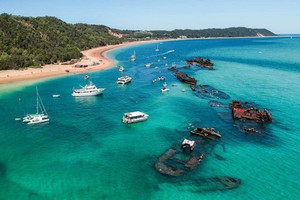
As the first port of call and exit point for most visitors to the Solomon Islands, Honiara is a hub which often gets overlooked as an attraction in its own right. First impressions can be misleading, and while very few people experience love at first sight with the city, it doesn’t take much effort to lift the lid and discover that it has a few attractions that are worthy of a day of exploration.
War Legacy
A gritty city of 50,000, Honiara is the main gateway to the Solomon Islands with an international airline terminal and major port. Understand, however, that it’s a working city far removed from the South Pacific cliché of hammocks and palm trees on a pretty beach, but it’s the type of place that can reveal a little charm if given a chance. Probably the best place to start is the US War Memorial which is perched on the top of Skyline Drive overlooking Honiara and the Sealark Channel and Iron Bottom Sound to the Florida Islands in the distance. It’s a wonderful lookout in its own right and down below is the Mataniko River and villages which dot the jungle into the distance. The Memorial itself is a serene reminder of the fact that the Solomon Islands, and the island of Guadalcanal in particular, was one of the major battlegrounds for control of the South Pacific during World War II. The US War Memorial was officially opened on August 7, 1992, to mark the 50th anniversary of the landing of US troops on Guadalcanal which resulted in huge losses for both the Americans and Japanese forces with major air, sea and land battles in the region. Honiara itself was born out of the war, and was originally the site of the fiercest fighting during WWII. It officially became the capital of the country in 1952, which goes some way to explaining its sometimes ramshackle appearance.
The National Parliament
The US War Memorial is an important historical sight, which also offers a sense of scale to the region, and the National Parliament is another of the city’s sights which has played a vital role in the development of the Solomon Islands. It’s a conical shaped building which sits on a hill and overlooks the city and is the symbol of the country’s independence, and a reminder of its often-chaotic recent past. The hallways are lined with original artwork, mostly paintings, and the parliamentary chamber itself features design touches which incorporate elements of all nine regions that make up the Solomon Islands. “That guy there, he was assassinated. So was that guy,” explains our guide as we pass by photographs of the country’s politicians. “This one was arrested on corruption charges ... and that one too.” The Solomon Islands’ brief and colourful political history is every bit as fascinating as the decor inside the National Parliament and it’s possible to sit in on proceedings from the public gallery when they convene for one week every other month. The Solomons gained independence from Britain in 1978 and in 1999 tribal hostilities broke out and Australia led the Regional Assistance Mission to Solomon Islands (RAMSI) in 2003. In 2006 there was further riots and turmoil but now hostilities have ended and an elected government is back in power.
The National Museum, Botanical Gardens
Back in the town centre on Mendana Avenue, which runs along the harbour front, is the National Museum which is a modest building which houses traditional handicrafts and artifacts including weapons along with photographs of traditional dances and body ornamentation. It’s an interesting introduction to the region’s culture and right behind the Museum is the Cultural Centre which features the different architectural styles from the Solomon Islands. Also next door to the Museum is the National Archives which contain the most extensive collection of historical material on the Solomon Islands. Another of Honiara’s popular attractions is the Botanical Gardens, which are just behind the Solomon Islands Broadcasting Corporation. It’s a quiet and peaceful place with a fresh water stream running through the middle and the caretakers have collected flora and fauna from throughout the Solomon Islands. Many important plants were stolen during the civil unrest but the walking trails still make it a pleasant spot to spend an hour or two.
Shopping And More
Perhaps the best thing about Honiara is its shopping and it’s a good place to find traditional and authentic handicrafts from throughout the country. Central Market is the country’s main food market situated between Mendana Avenue and the harbour front and it’s a colourful sprawl of fresh produce including fruit and vegetables, along with handicrafts like money shells from Malaita, jewellery and wood carvings. Temporary markets also pop up around the city, and there’s a few good shops as well which sell combs, bowls, carved sharks (which are considered lucky as they are believed to represent the soul of a successful fisherman), wooden dolphins, shell necklaces, rattles, flutes, panpipes, carry bags, traditional jewellery such as headbands, ear rings, nose and ear plugs, pendants, breastplates and armbands. Quite simply the range of arts and crafts is far greater than on the outer islands and the shopping itself is a good introduction to, or farewell from, the Solomon Islands. There’s no bargaining expected, and no hawking or haggling from the locals. The only real drama is leaving enough room in your luggage to carry it all back.
- By:
- Ben Hall
Reviews
-
Honiara an amazing insight into the way the Pacific was midway through the last century.
I was fortunate to visit the Solomon Islands at the beginning of the 1980s. I found the military history of this region fascinating. There were landing vessels from WW2 on the shoreline or just off the beach where you were able to snorkel. The number and variety of tropical fish which could be seen even when paddling was amazing. I loved kayaking in Iron Bottom Sound as well watching the inter island ferries arriving and departing. It’s worth travelling to some of the other islands too if you are able as life is carried on as it has been for centuries so they offer a fascinating insight into the country. My abiding memory is hearing the beautiful singing from the church on Sundays and visiting the markets where there was all types of tropical fruit and vegetables on sale. A truly fascinating part of the world.












